Automotive Belts and Hoses Market Size
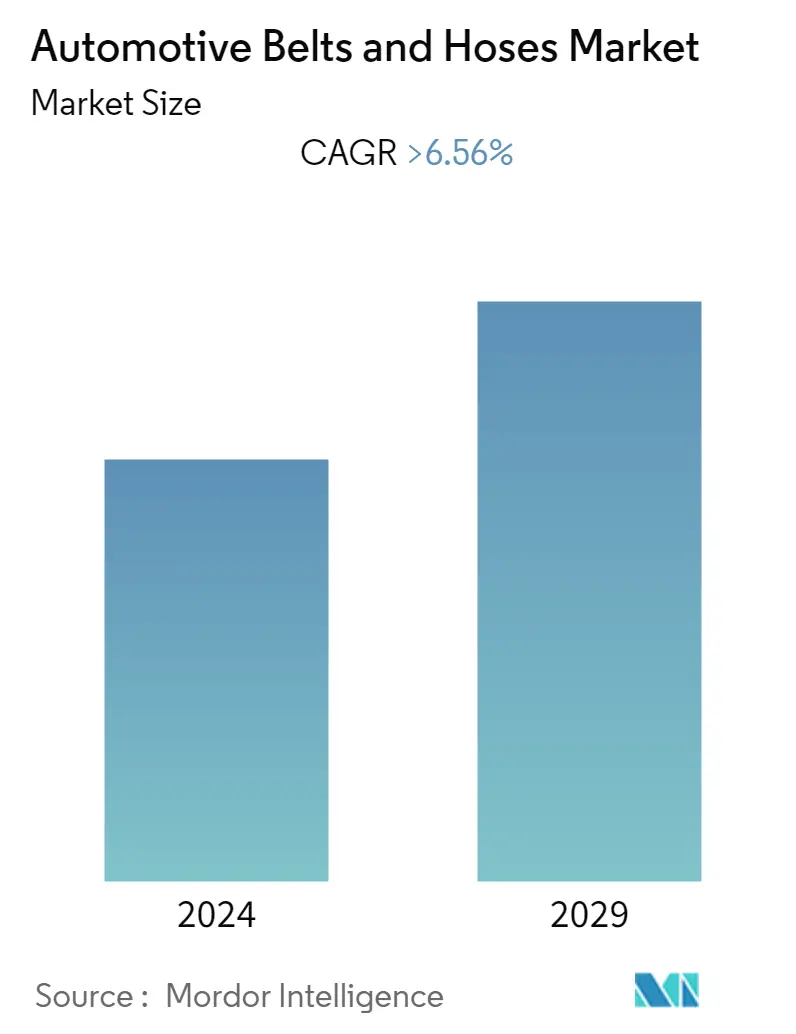
| Study Period | 2019 - 2029 |
| Base Year For Estimation | 2023 |
| CAGR | > 6.56 % |
| Fastest Growing Market | Asia Pacific |
| Largest Market | North America |
| Market Concentration | Low |
Major Players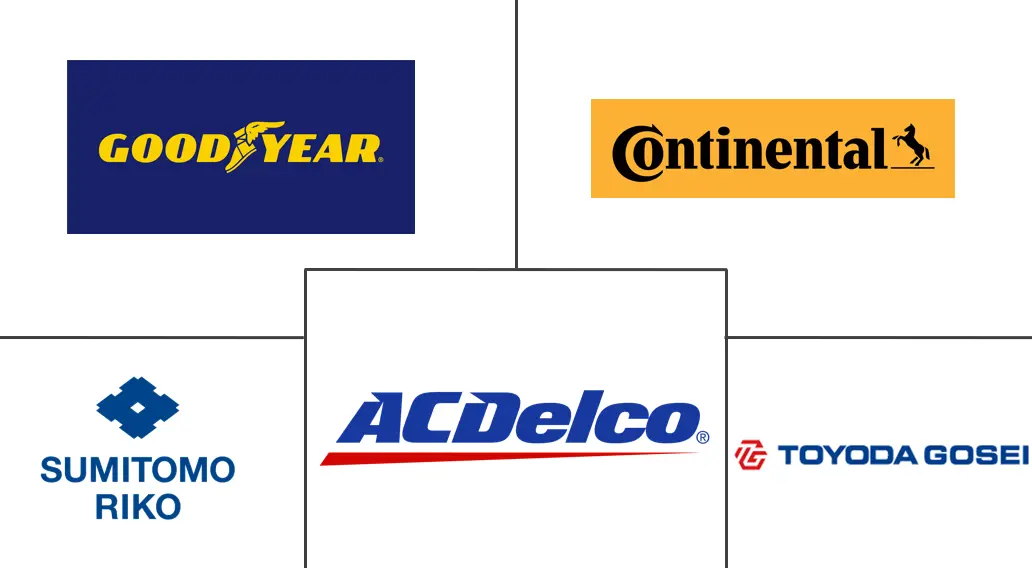
*Disclaimer: Major Players sorted in no particular order |
Automotive Belts and Hoses Market Analysis
The automotive belts and hoses market was valued at USD 21.53 billion in 2021 and is expected to surpass a net valuation of USD 31.51 billion by 2027 end, registering a solid CAGR growth of 6.56% during the forecast period.
The COVID-19 pandemic had a negative impact on almost all segments of the automotive industry including passenger and commercial vehicles during 2020 due to the lockdowns and halted production, impacting negatively demand for automotive cylinder liners. But with life returning to normalcy, the auto sector started seeing positive trends by the first half of 2021 as the production of vehicles picked up. For instance, in 2021, the global car sales were around 66.7 million, which in 2020 were 63.8 Million. Such trends are expected to help the automotive cylinder liner market grow in the forecast period.
Over the medium term, the demand is expected to be fuelled by the increasing vehicle sales and growing demand for powertrains and other ancillary components. Further, the stringency of emission control norms of the EPA and CAFE has led to improvements in exhaust and turbocharger hoses. Manufacturer across the globe are upbringing advancements and technological adoption to portray strong demand for belt and hoses.
In addition, with OEMs maintaining strong and longer term supply, belts and hoses manufacturers are expected to witness high growth rate during the study period. Innovations in technology are resulting in technological advancements in terms of product design and the materials used in automotive belt manufacturing to offer lucrative opportunities for players in the market. However, In the coming years, increasing inclination towards beltless engines are expected to restrain market growth.
In terms of regions, Asia-Pacific expected to lead the market during the forecast period. The market is driven by the increasing demand for automobiles, and economic development of China, Japan, India, and South Korea during forecast period. North America and Europe are the other two major markets owing to the presence of major OEMs, tier players, and raw material suppliers along with the established supply chain.
Automotive Belts and Hoses Market Trends
This section covers the major market trends shaping the Automotive Belts & Hoses Market according to our research experts:
Rising Sales of Passenger Cars to Enhance Market Growth During Forecast Period
Owing to the increasing demand for fuel efficiency in vehicles, the adoption of turbochargers has increased significantly in the passenger car segment. Hoses are deployed around the turbocharger system to predominantly handle the temperatures of exhaust gases. These belts and hoses are installed in the engine assembly to perform the desired function and increase fuel efficiency. Despite challenges such as the impact of ongoing chip shortages, and the worsening inflationary crisis due to ongoing war the market for passenger cars rebounded by 2021.
With rising sales of the passenger car segment, demand for belts and hoses is expected to witness promising growth during the forecast period. In full-year 2021, global car sales were slightly stronger in most major regions of the world. China remained the largest and best-performing major single-country car market in the world with sales up 6.6% to more than 21 million vehicles. In India, car sales grew even faster at 27% but the overall vehicle market remained relatively small.
Considering the ongoing developments and factors, hose and belts manufacturers have started investing in the production of high-performance hoses and belts to capture the growing demand from the automotive market. For instance, In May 2021, Continental has announced the transfer of production lines from the induction systems factory in Nadab to the production location of heating / cooling rubber hoses in Carei. In addition, the operational transfer will be formed gradually till 2022 end. Such advancements in the market expected to have positive influence on the market during forecast period.
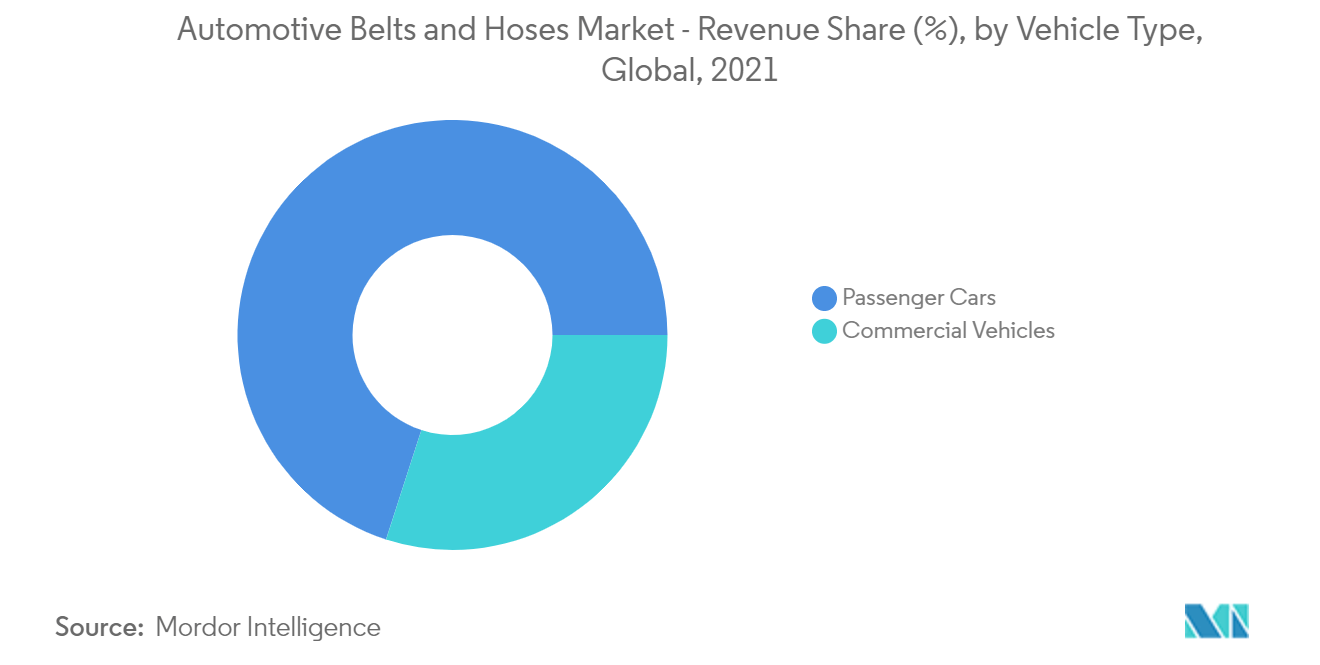
Asia-Pacific Region Expected to Grow Significantly During the Forecast Period
The growing automobile sector in Asia-Pacific, with India and China emerging as automotive part manufacturing hubs for the Western automobile giants, is expected to drive the market for belts and hoses in this region.
Additionally, with the growing sales of hybrid and electric vehicles in the region, the demand for high-performance and lightweight belts and hoses (primarily made of polymer) is likely to grow in line with the production of electric vehicles during the forecast period.
- China, which is the largest electric vehicle market in the world, has been backed up by generous support from the government. China has extended the incentives related to the purchase of new energy vehicles (NEVs) till 2022. In January 2020, Tesla Motors inaugurated a USD 2 billion facility in Shanghai that was assembling nearly 3000 cars per week in March 2020, when all the other global facilities of the electric vehicle giant were shut down due to the COVID-19 pandemic.
Considering the fact that demand is deeply dependent on the vehicles sales, and with government ongoing initiatives to propel electric vehicle demand in countries like India, China, South Korea, Japan are thus expected to create opportunity pockets for hose and belts adoption. For instance:
- In May 2022, Toyota Group revealed plans to invest INR 48 billion (USD 624 million) in India to manufacture electric vehicle components. In addition, government of India has undertaken multiple initiatives to promote the manufacturing and adoption of electric vehicles in India to reduce emissions pertaining to international conventions and develop e-mobility in the wake of rapid urbanization.
- By 2030, Japan wants next-generation vehicles to account for 50-70 percent of new vehicle sales, with battery electric vehicles (BEVs) and plug-in hybrid electric vehicles (PHEVs) accounting for 20-30 percent and hybrid electric vehicles (HEVs) accounting for 30-40 percent. To achieve that, in November 2021, The Japanese government earmarked a total of JPY 37.5 billion (EUR 290 million) for e-mobility
- The South Korean government intends to significantly expand the infrastructure for electric vehicles. By the end of this year, there should be more than 1,000 charging stations along highways.
Considering this ongoing government initiative to propel the electric vehicle demand, market for hose and belts is expected to witness highest growth rate during the forecast period.
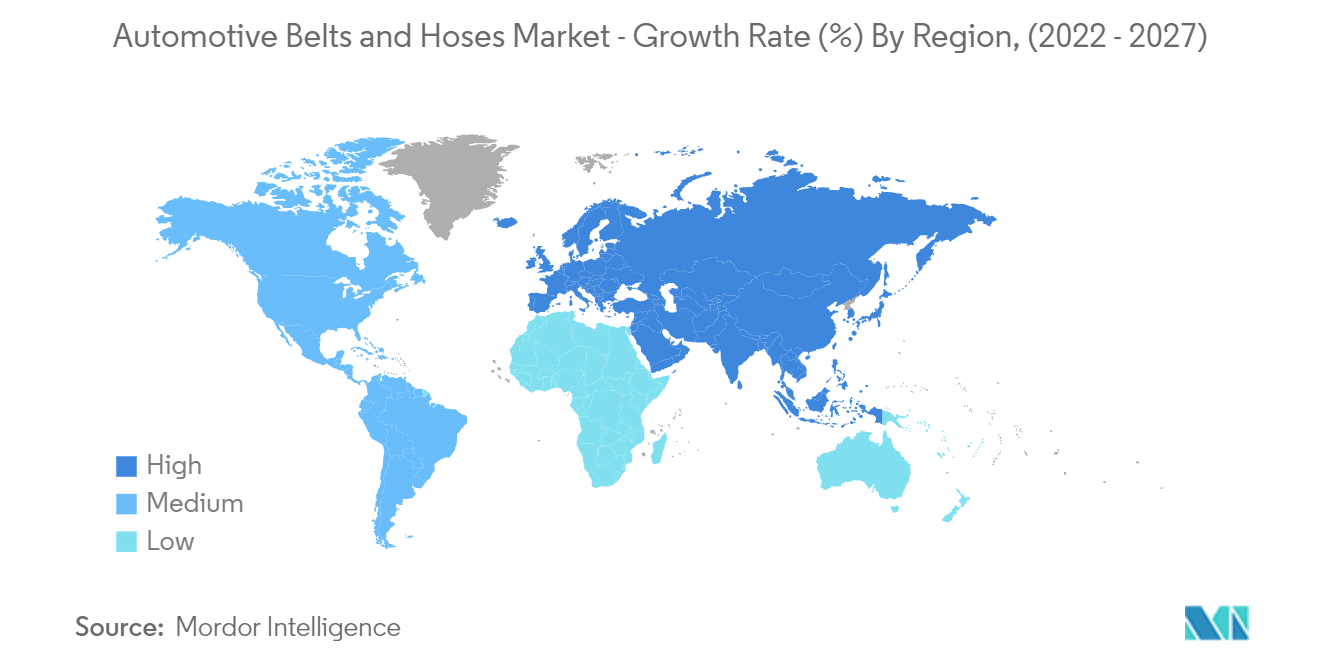
Automotive Belts and Hoses Industry Overview
The automotive belts and hoses market is highly fragmented, due to the presence of many regional players. However, some of the major players, like Sumitomo Riko Co. Ltd, ACDelco (General Motors), Goodyear Tire & Rubber Co., Toyoda Gosei Co. Ltd, and Continental AG, have captured significant shares in the market.
With the growing trend of lightweight and fuel-efficient vehicles, companies have started investing in the production of more advanced materials for belts and hoses, in order to meet the increasing standards of the automotive industry. For instance,
- In July 2022 Origin Material, inc has partnered with Intertex World Resources which is the leading distributor of synthetic rubber, processed oils, plastics, etc. The partnership further aims to hoses, belts, rubber seals, and all other mechanical rubber goods markets for automotive aftermarkets and OEMs.
- In March 2020, Teijin Frontier, Kita Ward, Osaka) announced that it has developed an eco-friendly adhesive that doesn't contain resorcinol-formaldehyde (RF) for rubber reinforcement fibers. The company aims to start the pilot production of rubber reinforcement fibers that use this new adhesive in 2020, and to achieve an annual production of 200,000 tons including the amount of licensed production in 2028. As for commonly used RF latex (RFL) adhesives, RF is reticulated by chemical reaction and is combined with latex, an adhesive element, to deliver adhesive performance.
Automotive Belts and Hoses Market Leaders
-
Sumitomo Riko Co. Ltd
-
ACDelco (General Motors)
-
Toyoda Gosei Co. Ltd
-
Continental AG
-
Goodyear Tire & Rubber Co.
*Disclaimer: Major Players sorted in no particular order
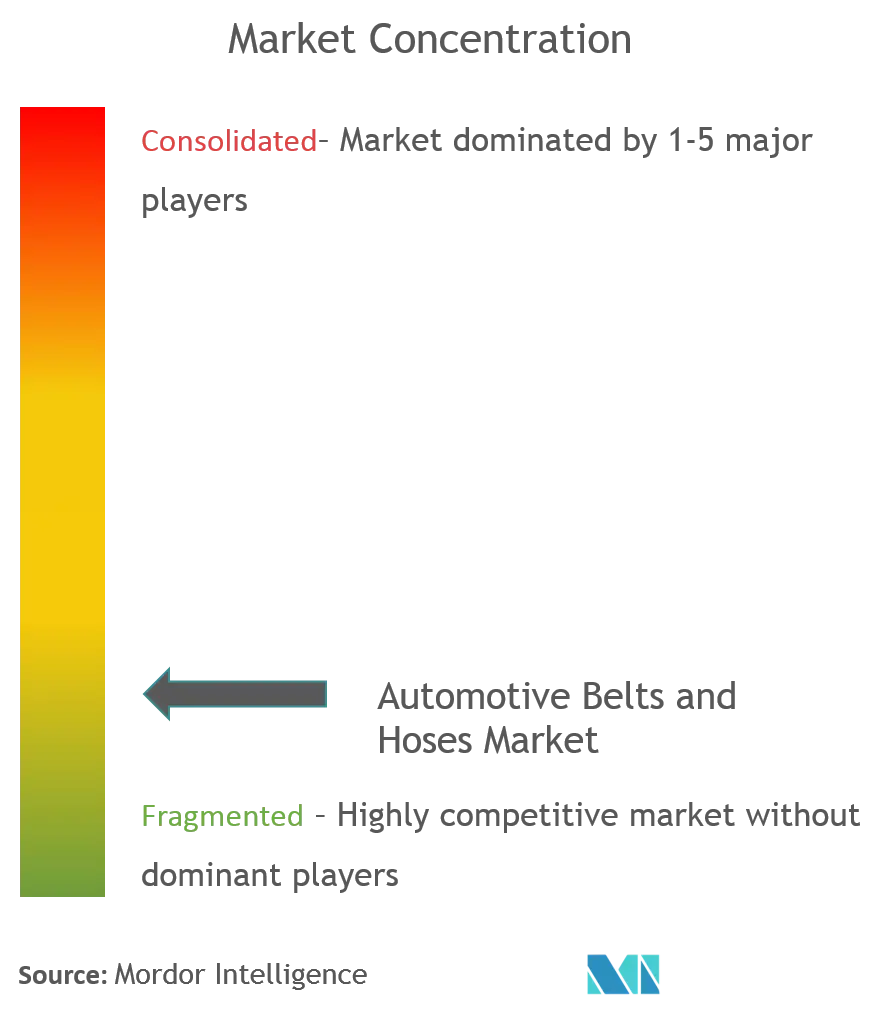
Automotive Belts and Hoses Market News
- In September 2022, KA)merged Fluid Transfer Systems (FTS) and Couplings business units to create a new 'Flow Control Systems business unit. KA's FTS business unit supplies PTFE hoses and hose assemblies to various industrial and automotive markets. The couplings business is a supplier of compressed air couplings to the global commercial vehicle market.
- In July 2022, Continental AG's industrial segment ContiTech has recently announced the launching of the major restructuring hose sites in Germany. According to Conti, the automobile industry's transition has resulted in an oversupply of rubber hoses for combustion engines.
- In February 2021, Yokohama Rubber announced that it has developed a system that utilizes artificial intelligence (AI) to predict the physical properties of rubber compounds and launched the system in designing rubber compounds for Yokohama tires. The system was developed under Yokohama Rubber's new AI utilization concept, HAICoLab, which was launched in October 2020. Teijin Frontier intends to promote the new adhesive for a wide range of applications such as tires, belts, and hoses, and to further develop properties to respond to various kinds of rubber.
- In August 2021, Hungarian Investment Promotion Agency (HIPA) announced that the UK based Leyland Hose & Silicone Services (LHSS) has established its first European manufacturing unit in Hungary. As an automotive supplier, the company has been engaged in the manufacturing and sales of silicone hoses for more than 30 years.
LHSS decided in 2019 to open a new plant in response to market demand.
Automotive Belts and Hoses Market Report - Table of Contents
1. INTRODUCTION
1.1 Study Assumptions
1.2 Scope of the Study
2. RESEARCH METHODOLOGY
3. EXECUTIVE SUMMARY
4. MARKET DYNAMICS
4.1 Market Drivers
4.2 Market Restraints
4.3 Industry Attractiveness - Porter's Five Forces Analysis
4.3.1 Threat of New Entrants
4.3.2 Bargaining Power of Buyers/Consumers
4.3.3 Bargaining Power of Suppliers
4.3.4 Threat of Substitute Products
4.3.5 Intensity of Competitive Rivalry
5. MARKET SEGMENTATION (Market Size in Value USD Billion)
5.1 Belt Type
5.1.1 Drive Belt
5.1.2 Timing Belt
5.2 Hose Type
5.2.1 Fuel Delivery System Hoses
5.2.2 Braking System Hoses
5.2.3 Power Steering System Hoses
5.2.4 Heating and Cooling System Hoses
5.2.5 Turbocharger Hoses
5.3 Vehicle Type
5.3.1 Passenger Cars
5.3.2 Commercial Vehicles
5.4 Geography
5.4.1 North America
5.4.1.1 United States
5.4.1.2 Canada
5.4.1.3 Rest of North America
5.4.2 Europe
5.4.2.1 Germany
5.4.2.2 United Kingdom
5.4.2.3 France
5.4.2.4 Italy
5.4.2.5 Spain
5.4.2.6 Rest of Europe
5.4.3 Asia-Pacific
5.4.3.1 China
5.4.3.2 India
5.4.3.3 Japan
5.4.3.4 South Korea
5.4.3.5 Rest of Asia-Pacific
5.4.4 Rest of the World
5.4.4.1 Brazil
5.4.4.2 South Africa
5.4.4.3 Other Countries
6. COMPETITIVE LANDSCAPE
6.1 Vendor Market Share
6.2 Company Profiles
6.2.1 Sumitomo Riko Co. Ltd
6.2.2 ACDelco (General Motors)
6.2.3 Toyoda Gosei Co. Ltd
6.2.4 Continental AG
6.2.5 Goodyear Tire & Rubber Co.
6.2.6 Dayco IP Holdings LLC
6.2.7 Yokohama Rubber Co., Ltd.
6.2.8 Schaeffler AG
6.2.9 Nichirin Co., Ltd.
6.2.10 Hutchinson SA
- *List Not Exhaustive
7. MARKET OPPORTUNITIES AND FUTURE TRENDS
Automotive Belts and Hoses Industry Segmentation
Belts and hoses are responsible for the overall performance of the vehicle. Belts are an integral part of the engine's powertrain system that transmits power from the flywheel to the camshaft. Fuel efficiency is related to belts, as they regulate the valve positioning. Drive belts and timing belts are two categories of belts. Hoses are flexible pipes that allow the transportation of fluids with varying pressures.
The automotive belts and hoses market has been segmented by belt type, hose type, vehicle type, and geography. By Belt Type, the market has been segmented into drive belts and timing belts. By hose type, the market has been segmented into fuel delivery system hoses, braking system hoses, power steering system hoses, heating and cooling system hoses, and turbocharger hoses.
By vehicle type, the market has been segmented into passenger cars and commercial vehicles and By Geography, the market has been segmented into North America, Europe, Asia-Pacific, and the Rest of the World. For each segment, the market sizing and forecast have been done on basis of value (USD billion).
| Belt Type | |
| Drive Belt | |
| Timing Belt |
| Hose Type | |
| Fuel Delivery System Hoses | |
| Braking System Hoses | |
| Power Steering System Hoses | |
| Heating and Cooling System Hoses | |
| Turbocharger Hoses |
| Vehicle Type | |
| Passenger Cars | |
| Commercial Vehicles |
| Geography | ||||||||
| ||||||||
| ||||||||
| ||||||||
|
Automotive Belts and Hoses Market Research FAQs
What is the current Automotive Belts and Hoses Market size?
The Automotive Belts and Hoses Market is projected to register a CAGR of greater than 6.56% during the forecast period (2024-2029)
Who are the key players in Automotive Belts and Hoses Market?
Sumitomo Riko Co. Ltd, ACDelco (General Motors), Toyoda Gosei Co. Ltd, Continental AG and Goodyear Tire & Rubber Co. are the major companies operating in the Automotive Belts and Hoses Market.
Which is the fastest growing region in Automotive Belts and Hoses Market?
Asia Pacific is estimated to grow at the highest CAGR over the forecast period (2024-2029).
Which region has the biggest share in Automotive Belts and Hoses Market?
In 2024, the North America accounts for the largest market share in Automotive Belts and Hoses Market.
What years does this Automotive Belts and Hoses Market cover?
The report covers the Automotive Belts and Hoses Market historical market size for years: 2019, 2020, 2021, 2022 and 2023. The report also forecasts the Automotive Belts and Hoses Market size for years: 2024, 2025, 2026, 2027, 2028 and 2029.
Automotive Timing Belt Industry Report
Statistics for the 2024 Automotive Timing Belt market share, size and revenue growth rate, created by Mordor Intelligence™ Industry Reports. Automotive Timing Belt analysis includes a market forecast outlook 2029 and historical overview. Get a sample of this industry analysis as a free report PDF download.



